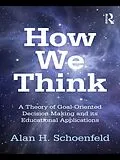Teachers try to help their students learn. But why do they make the particular teaching choices they do? What resources do they draw upon? What accounts for the success or failure of their efforts? In How We Think, esteemed scholar and mathematician, Alan H. Schoenfeld, proposes a groundbreaking theory and model for how we think and act in the classroom and beyond. Based on thirty years of research on problem solving and teaching, Schoenfeld provides compelling evidence for a concrete approach that describes how teachers, and individuals more generally, navigate their way through in-the-moment decision-making in well-practiced domains. Applying his theoretical model to detailed representations and analyses of teachers at work as well as of professionals outside education, Schoenfeld argues that understanding and recognizing the goal-oriented patterns of our day to day decisions can help identify what makes effective or ineffective behavior in the classroom and beyond.
Autorentext
Alan H. Schoenfeld is the Elizabeth and Edward Conner Professor of Education and Affiliated Professor of Mathematics at the University of California, Berkeley.
Inhalt
Introduction and Acknowledgments
1. The Big Picture
2. Reflections, Caveats, Doubts, and Rationalizations
3. The Structure of the Representations Used in this Book
4. Lesson Analysis I: A beginning teacher carrying out a traditional lesson
5. Lesson Analysis II: An experienced teacher carrying out a non-traditional lesson
6. Lesson Analysis III: Third graders! A non-traditional lesson with an emergent agenda
7. Lesson Analysis IV: The analysis of a doctor-patient
Consultation - an act of joint problem solving
8. Next Steps
Indices, etc
